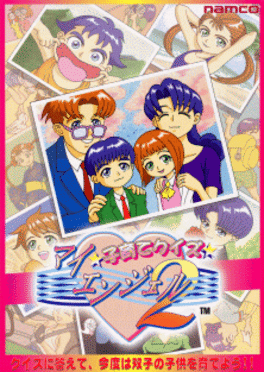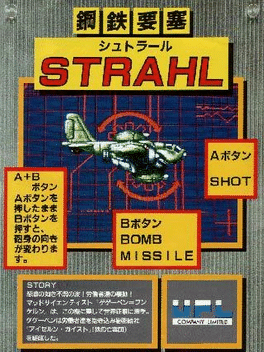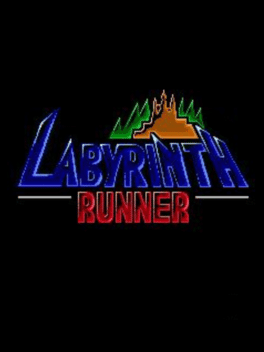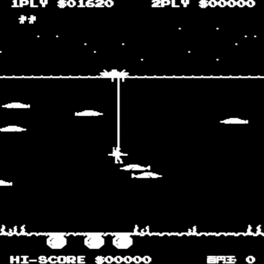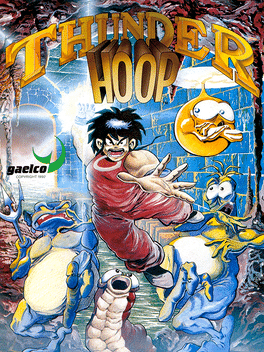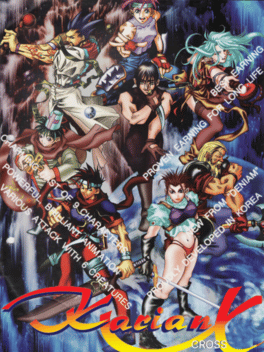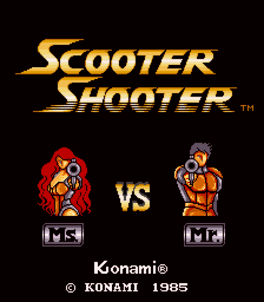Most Popular Arcade Games - Page 109
-
Korosuke Roller
1981
Korosuke Roller
1981
Time to take up your paint brush and paint the town Red (or Green or Orange, or whatever color you happen to have on hand)! A pair of fish are out to stop you but you can roll over them at the overpass. There's other items that just try to mess up your paint job; you can run over these folks easily (if you catch them). -
Kosodate Quiz My Angel 2
1997
KOSODATE QUIZ : MY ANGEL 2 is the second sequel of unique quiz simulation games in where players can enjoy assuming the role of a couple of newly parents who must raise their newborn daughter from the age of 0 until the age of 25. -
Koukuu Kihei Monogatari: The Legend Of Air Cavalry
1988
Known as Chopper 1 in U.S. A good paced vertical scrolling helicopter shoot 'em up. Enemies include choppers, tanks and boats. The usual sort of power ups are available, better weapons, smartbombs etc... Playing with the perspective there are also ground based obstacles that rise up giving you extra hazards to avoid. -
Koutetsu Yousai Strahl
1992
The game takes place in modern times where a great depression has swept over the world. Amidst the depression and its riots of jobless workers, a mad scientist starts his plan of world domination. Taking command in the titular fortress orbiting Earth, the evil Doctor Gegeben Funkerun uses his own robots, flying fortresses and mercenaries to wreak havoc across the globe until all his demands are met. Assisting the attacked and weakened governments, workers across the nations help develop a series of jet fighters called the Aizerun Geist to use against the forces of Dr. Funkerun and save the world. Before each stage begins, players are given a choice of weapons to purchase at a hangar for the Aizerun Geist. There are four weapons within three tiers to choose from including Main Attack, Sub Weapon and Bomb. Of the Main Attack the player can choose Twin Shot, Laser, Heavy Laser and the Charge Shot. Of the Sub Weapons, players can choose additional firepower, Homing Missiles, Shielded Options or an energy barrier. Play -
Kung-Fu Taikun
1984
-
Kyuukyoku Sentai Dadandarn
1993
A trio of supervillains unleashes an army of gross mutants on earth on order to start an alien invasion. Our only hope is the trio of superheroes known as the 'Ultimate Task Force'. Squash the evil mutants and put an end to the alien menace. Features excellent graphics & sound as well as plenty of moves to find! -
Labyrinth Runner
1987
Labyrinth Runner
1987
You control a warrior fighting through a labyrinth against spiders and other monsters. -
Jyangokushi - Haoh No Saihai
1999
A Mah Jong game based on the story of the romance of the three kingdoms. -
Kaiketsu Yanchamaru
1986
Kaiketsu Yanchamaru
1986
One day in Feudal Japan, Kid Niki, the most radical of ninjas, is training at his Ninja School. Suddenly, a passing bird is struck down by an arrow and lands at Niki's feet. Attached is a note explaining that Niki's girlfriend, Princess Margo, has been kidnapped by the evil Stone Wizard. With the cry of "Will help you!" Niki bursts through the wall of his school and sets off on his quest to save Margo. -
Kaitei Daisensou
1993
Kaitei Daisensou
1993
Also known has In the Hunt outside of Japan. An organization known as the D.A.S. (The Dark Anarchy Society) uses magnetic doomsday machines to melt the polar ice caps and thus desolate the world. Although the entire world is flooded, a few societies survive to build over the highest structures they can find and continue living. In this post apocalyptic scenario, the D.A.S., who were prepared for this catastrophe, reign supreme over the survivors with martial law and military weapons of extraordinary power. Upon learning of a new D.A.S. superweapon being developed, "Yugusukyuure", the remaining survivors who are terrorized by D.A.S. secretly organize a rebellion force using a newly developed submarine known as the Granvia. The Granvia’s mission is to dive into D.A.S. enforced waters, territories and eventually the D.A.S. headquarters itself to destroy every single D.A.S. weapon in sight. -
Kaitei Takara Sagashi
1980
Use the 2-way joystick to direct the boat across the surface of the ocean, then press the button to lower the diver down to the bottom of the ocean while watching out for the sharks swimming across the screen. During this time, you can hold the button to pause the diver's descent and push the joystick in either direction to fire a harpoon at the sharks for 30-300 points apiece. Once the diver has reached the bottom of the ocean, push the joystick in either direction to make him walk towards either of the two treasure caches that are closest to him (the boat will automatically follow his movements at this point). When the diver is directly over a treasure cache, the boat will lower him into it. The amount of points you will receive when you make it back onto the surface of the ocean, which can range from 50-250, will then appear on the screen, and the boat will raise the diver back up to the surface of the ocean. Once again, you can hold the button to pause the diver's ascent, and push the joystick in either directi -
Thunder Hoop
1992
Thunder Hoop
1992
Thunder Hoop is a 2D side-scrolling platform game that puts players in the shoes of Thunder Hoop. Thunder Hoop has to stop the uncontrollable creatures professor Genbreak has released into to the world. Genbreak was forbidden to continue his dangerous research in creating these creatures, but exasperated, he created them all the same. Thunder Hoop was specifically developed in a laboratory to counter these creatures. -
Karian Cross
1997
Karian Cross
1997
An adventure puzzle game similar to Puyo Puyo. The player must combine falling blocks. Longer combinations create additional blocks in opponents screen. -
Jitsuryoku!! Pro Yakyuu
1989
Japanese professional baseball game with fake player names. This is the arcade version of the popular NES baseball game. -
Joinem
1983
-
Zero Team USA
1993
Zero Team USA
1993
Choose from one of four super hero type characters and fight your way through multiple end of level bosses to reach the end. Power-ups and bonuses can be collected by breaking up background objects. This game is simular in game play to Double Dragon, but it has improved graphics and a greater variety of enemies. -
Joyman
1982
-
Ju Ju Densetsu
1990
Ju Ju Densetsu
1990
According to the TAD president, Tadashi Yokoyama: One day in December 1988, a freelance artist came at TAD with a portfolio of designs including this monkey. The team was motivated to do a game around this funny monkey. On February 02, 1989, the first prototype was ready: one level, no enemies, no musics and the monkey can jump only (no shoot). At this point, they decided to reprogram the game entirely from 0. Note JuJu Densetsu was coded with the same system used by the neogeo coders at SNK. During the first location test (at the TAD office) on September 07, 1989, many new ideas came to the developers but most of them were not included in the final product (i.e: snakes on the first stage), because lack of time. On September 15, 1989. a public location test was done in Japan AND in the USA (University of Washington). A second test was done in October. After this test, they decided to program the end of the game (done by a non-programmer in a week-end). Note: The girl you have to save is brune in the attrac -
Jumping Cross
1984
-
Scooter Shooter
1985
Scooter Shooter
1985
Scooter Shooter is a horizontal-scrolling shooter arcade game developed by Konami in 1985 with competitive play against either a computer opponent or another player.

